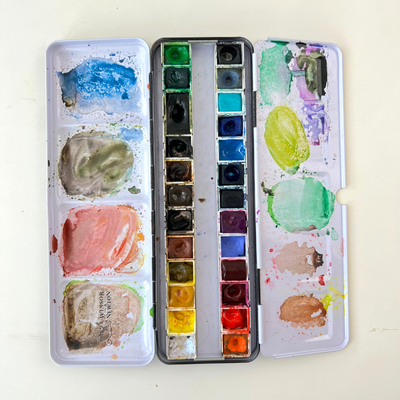Kuretake Gansai Tambi Watercolor Review
Kuretake Gansai Tambi is a watercolor paint made by the Kuretake company in Japan. It comes in several colors and can be used for painting and calligraphy. The range of colors available makes it easy to find the right shade for your project without mixing colors. It’s different from traditional watercolor and comes with benefits and downsides.
Table of Contents
- How is Kuretake Gansai Tambi Watercolor different from Western Watercolor?
- Benefits of Kuretake Gansai Tambi Watercolor
- Downsides of Kuretake Gansai Tambi Watercolor
- Conclusion
How is Kuretake Gansai Tambi Watercolor different from Western Watercolor?
The Kuretake Gansai Tambi Watercolors are different from Western watercolors in several ways.
- The most significant difference is in the binding process: Western watercolors are usually bound with gum Arabic, a natural gum consisting of hardened sap from the acacia tree. At the same time, Gansai paints use a different binder (water-soluble resin) that creates a semi-glossy to glossy painting.
- Gansai paints are very pigmented and are thicker and creamier than Western watercolors. They tend to be less transparent than Western or European watercolors but can be thinned with water to create more transparent washes.
- They are supposed to be used in a single layer rather than layered.
- They were traditionally used on rice paper, with very few (if not any) flowing and bleeding.
- Traditional Japanese watercolors have a different range of colors to those used in Western paintboxes.
- They come in large pans (48 x 28 mm) for traditional Japanese watercolor brushes with long bristles.
- All pans are labeled, and the lid has a swatch paper ready to paint.

Benefits of Kuretake Gansai Tambi Watercolor
Some benefits of using Japanese watercolors come down to your style of painting. Some advantages to me are downsides to you!
- They are very affordable. If you compare the size of Japanese pans to half pans, you’ll quickly see the difference! It’s about $1 per pan. If you click on the image below, you can buy your set (affiliate link, it won’t cost you anything more, but it helps to support the channel.)

- They come in a range of vivid colors that are easy to mix.
- Because their colors are made from Japanese landscapes, so they have unusual pigments for our Western eyes. This can open many creative possibilities when you change from your regular color palette.
- If you use very little water, the colors are opaque, almost like gouache.
- You can thin them with water to make transparent washes.
- You can use Gansai watercolors on different kinds of papers, not only watercolor paper. So it’s a good option for sketchbooks and journaling.
- Because of the specific binder in Gansai, it’s easy to lift off with a wet brush when you want to lighten or remove colors.
- There is a semi-opaque white pigment, perfect for adding a glaze to lighten colors.
- Large pans are easy to use. You can roll your brushes to grab a lot of pigments without damaging the bristles.

Downsides of Kuretake Gansai Tambi Watercolor
Even if they are fun to use and so cute to watch, they have some downsides:
- Because Japanese watercolors are traditionally used on absorbent paper, they have been formulated to prevent paint from spreading. Once the color is on the paper, it doesn’t flow well.
- If you like blossoms (cauliflower effects), it won’t be easy to achieve with Gansai watercolors. It takes some time to get used to the lack of flowing. But you can use a lot of water in your mix and still get interesting effects.
- The pans are loose inside the palette. When you rub the brush, it moves and clicks on the other pans. That’s quite annoying! You can fix the pans in their drawer with sticky gum.
- They have no pigment or lightfast information. Even if the manufacturer says they are lightfast, I won’t use them to sell my art.

Conclusion
Kuretake Gambai Japanese Watercolor is a great way to get started with watercolors, and it has everything you need in one box. The colors are vibrant and fun, working well together as a set.
Depending on your watercolor painting style, you might like them or not for their opacity, colors, and flow control. If you use a lot of water and want to create washes with multiple colors, this might not be your set. But this is an excellent option if you are looking for vibrant colors that are easy to blend, affordable, and work together.





